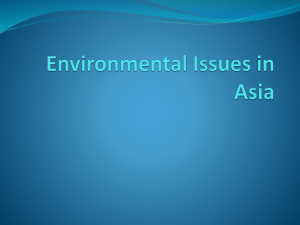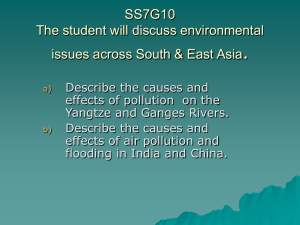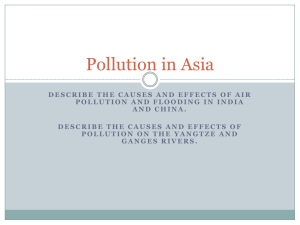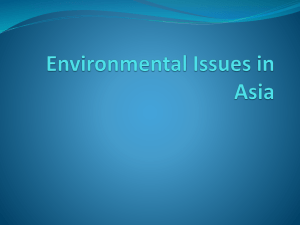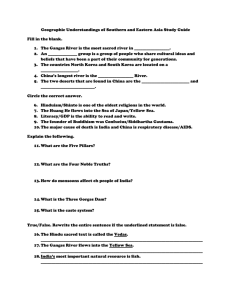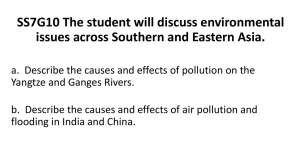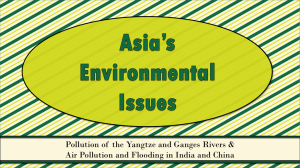Dreadful Air and Terrible Water!
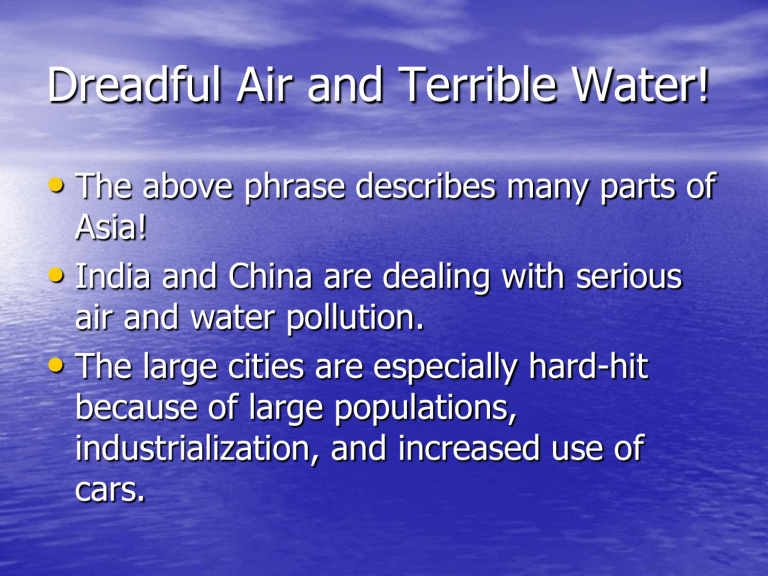
Dreadful Air and Terrible Water!
• The above phrase describes many parts of
Asia!
• India and China are dealing with serious air and water pollution.
• The large cities are especially hard-hit because of large populations, industrialization, and increased use of cars.
When China was preparing for the
2008 Olympics, it banned half the cars from driving each day in an effort to clean up its polluted air!
SS7G10: The student will discuss environmental issues across
Southern and Eastern Asia.
a. Describe the causes and effects of pollution on the Yangtze and Ganges Rivers.
Yangtze River (Chiang Jiang)largest and longest river in China
• More than 7% of the world’s population or
400 million people live along the banks of the Yangtze
River
• Billions of tons of chemicals and waste from agriculture, industry, and people pour into the river every year.
• Because of the river’s vast size, the pollution is somewhat diluted.
• Nevertheless, the nitrates from farm runoff enable algae to multiply, decreasing oxygen that fish need to survive.
• Pollution has killed the smaller fish in the river and harmed the larger ones, so that many people are afraid to eat any fish caught there.
• Hundreds of millions of Chinese villagers do not have safe drinking water because water sources like lakes, rivers, and aquifers have been polluted by industry.
• Cities have also been affected. When water quality is tested and water is too polluted to drink, city residents drink bottled water. Schools sometimes close because there is no clean water for students.
Ganges River—sacred to Hindus
• the river runs 1,560 miles
• Varanasi is the holiest city along the river
• Hindus bathe in the
Ganges at Varanasi during important festivals of the
Hindu religion
• the Ganges River is highly polluted with dangerous bacteria
• about 300 million gallons of untreated sewage, trash, and food are poured into the Ganges daily
• experts estimate that about 80% of all illnesses and 1/3 of all deaths in India come from diseases carried by dirty water
• Hindus believe that they will have a peaceful journey to the next life if their ashes are strewn in the Ganges River.
• Families who cannot afford that process often place the body of their family member in the river instead.
• Animal carcasses are deposited there as well, adding to an already dangerous situation.
• Many of India’s sewage systems are simply overwhelmed since they were designed in the early 1900s and haven’t been updated, even though the population in India has soared over the last century.
SS7G10: The student will discuss environmental issues across
Southern and Eastern Asia.
• b. Describe the causes and effects of air pollution and flooding in India and China.
Hold your breath!
• Industry is growing in China, and air pollution is growing with it.
• In a recent study by the World Bank,
China is home to 16 of the 20 most polluted cities in the world.
• The World Health Organization (WHO) says that China pumps 1/3 of the world total of pollutants (sulfur dioxide, ozone, nitrogen dioxide) into the world’s air.
• Burning fossil fuels such as coal and petroleum to power Chinese industry and cars is a major source of pollution.
• Chinese people also burn coal to heat their homes, adding to the pollution problem.
A vendor delivers coal briquettes which are mostly used to fuel small coal burners for heating and cooking for low-income homes and restaurants, in an old neighborhood in Beijing.
Effects of air pollution:
• lost work due to illness
• early deaths
• chronic bronchitis
• cancer is leading cause of death in China
• only 1% of China’s 560 million city dwellers breathes safe air
This satellite image shows the prevalence of air pollution over the entire world. Which areas pollute the most? Why? Which areas pollute the least? Do you have any ideas about why that is?
Keep holding your breath!
• India has many of the same air quality problems as China
– industry is growing
– more cars on roads
– rapidly growing population
• Indoor air quality is a growing problem, as well
– people cook using unprocessed fuel that emits toxic fumes
• India is investing money in cleanup efforts but the growing population outpaces its efforts.
• The Taj Mahal, a sacred site and popular tourist destination, is growing yellow from pollution.
• Some experts believe that smog from
India and China could possibly change weather patterns in North America.
Rain, Rain, Go Away!
• Monsoon—a seasonal wind bringing heavy rainfall that can lead to flooding
• Monsoons are a mixed blessing for India
– Farmers depend on rain for their crops
– The huge amounts of water are used to generate electricity
– Cause heavy flooding which makes rivers overflow their banks
• Destruction
• Water-borne diseases
• Annual monsoon rains in China pose the same problems as the rains in India
– Beneficial to farmers
– Cause floods, usually every 2 to 3 years
– Monsoon season in China is March through
August
– Flooding from China’s Huang He has killed more people than flooding from any other river in the world
• 1887—nearly 2 million died
• 1931—almost 4 million died
• Huang He River flows through China’s major farming area and picks up fertile yellow topsoil along its path. The silt builds up so that the river is higher than the surrounding plains. The Chinese have constructed dikes to manage the river.
However, when the dikes fail and the river floods, homes and crops are buried and lives are lost.
• Monsoon rains also swell the Yangtze
River.
– Loggers working upstream cut down trees that used to help contain flooding
(deforestation!)
– Farmers downstream have drained wetlands that used to act as sponges during floods
(wetland loss)
– These two actions have multiplied the effects of the monsoon rains and cause storm water runoff.
